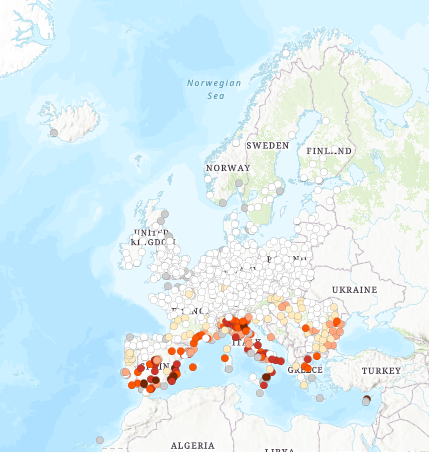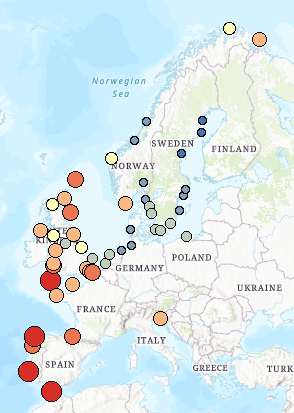Switzerland
Type of resources
Available actions
Topics
INSPIRE themes
Keywords
Contact for the resource
Provided by
Years
Formats
Representation types
Update frequencies
status
Scale
Resolution
-

The grid is based on proposal at the 1st European Workshop on Reference Grids in 2003 and later INSPIRE geographical grid systems. The sample grid available here is part of a set of three polygon grids in 1, 10 and 100 kilometres. The grids cover at least country borders and, where applicable, marine Exclusive Economic Zones v7.0, http://www.marineregions.org. Note that the extent of the grid into the marine area does not reflect the extent of the territorial waters.
-

The grid is based on proposal at the 1st European Workshop on Reference Grids in 2003 and later INSPIRE geographical grid systems. The sample grid available here is part of a set of three polygon grids in 1, 10 and 100 kilometres. The grids cover at least country borders and, where applicable, marine Exclusive Economic Zones v7.0, http://www.marineregions.org. Note that the extent of the grid into the marine area does not reflect the extent of the territorial waters.
-

A 10m high resolution raster layer containing height information is generated for core urban areas of selected cities (capitals in EU28 + EFTA) as part of the Urban atlas. Height information is based on IRS-P5 stereo images and derived datasets like the digital surface model, the digital terrain model and the normalized DSM.
-

The dataset presents average values of the number of days per year where the maximum temperature has exceeded 35 degrees Celsius from the period 1987- 2016, for a series of individual European cities from Eurostat's Urban Audit 2011-2014 spatial dataset. The associated values are based on the E-OBS dataset from the EU-FP6 project ENSEMBLES (http://ensembles-eu.metoffice.com) and around 10,000 meteorological stations across Europe. This dataset has been used also in the EEA Report No 22/2018 "Unequal exposure and unequal impacts: social vulnerability to air pollution, noise and extreme temperatures in Europe" (https://www.eea.europa.eu/publications/unequal-exposure-and-unequal-impacts/at_download/file).
-

The dataset presents the average number of combined hot days - with maximum temperature over 30 degrees Celsius - and tropical nights - with minimum temperature over 20 degrees Celsius - in the period 1987-2016, for a series of individual European cities from Eurostat's Urban Audit 2011-2014 spatial dataset. The associated values are based on the E-OBS dataset from the EU-FP6 project ENSEMBLES (http://ensembles-eu.metoffice.com) and around 10,000 meteorological stations across Europe. The combination of hot days and warm nights is particularly dangerous to human health, as the high temperatures during night time does not allow for the cities and buildings to cool down. Such combination, if lasting over several days (heatwaves) can have severe health implications or even be fatal to the elderly, babies or those in poor health. Therefore, the knowledge of the occurrence of such conditions in a given location can be useful in planning adaptation to the changing climate and protection of the vulnerable groups from heat. This dataset has been used also in the EEA Report No 22/2018 "Unequal exposure and unequal impacts: social vulnerability to air pollution, noise and extreme temperatures in Europe" (https://www.eea.europa.eu/publications/unequal-exposure-and-unequal-impacts/at_download/file).
-

The Common Database on Designated Areas (CDDA) is more commonly known as Nationally designated areas. It is the official source of protected area information from European countries to the World Database of Protected Areas (WDPA). The inventory began in 1995 under the CORINE programme of the European Commission. It is now one of the agreed Eionet priority data flows maintained by EEA with support from the European Topic Centre on Biological Diversity. The CDDA data can be queried online in the European Nature Information System (EUNIS). Geographical coverage of GIS vector boundary data: Albania, Austria, Belgium, Bosnia and Herzegovina, Bulgaria, Croatia, Cyprus, Czech Republic, Denmark, Estonia, Finland, France, Germany, Greece, Hungary, Iceland, Ireland, Italy, Kosovo under UNSC Resolution 1244/99, Latvia, Liechtenstein, Lithuania, Luxembourg, the North Macedonia, Malta, Montenegro, the Netherlands, Norway, Poland, Portugal, Romania, Serbia, Slovakia, Slovenia, Spain, Sweden, Switzerland and United Kingdom. EEA does not have permission to distribute some or all sites reported by Austria, Estonia, Hungary, Ireland, Romania and Turkey. When re-using the data, copyright is to be mentioned specifically for Estonia and for Finland: "Estonian Environmental Register 01.01.2016; "©Finnish Environment Institute, 2016".
-

This vector dataset presents the delineation of the Emerald Network Areas of Special Conservation Interest for the reference year 2016. The dataset covers non-EU Contracting Parties and Observer States to the Bern Convention. The dataset includes both adopted and candidate sites. For this particular dataset, there are only adopted sites in BY, CH and UA. The Emerald Network is an ecological network made up of Areas of Special Conservation Interest. Its implementation was launched by the Council of Europe as part of its work under the Bern Convention, with the adoption of Recommendation No. 16 (1989) of the Standing Committee to the Bern Convention. The objective of the Emerald Network is the long-term survival of the species and habitats requiring specific protection measures listed respectively in Resolution No. 4 (1996) and Resolution No. 6 (1998) of the Standing Committee to the Bern Convention. The Network is to be set up in each Contracting Party or observer State to the Convention. It thus involves all the European Union member States, some non-Community States and a number of African States. As a Contracting Party, the European Union contributes to the Emerald Network with its Natura 2000 sites.
-

The natural assemblage species indicator dataset is a forest dataset that measures the congruency between the potential and current tree species distribution. The natural assemblage indicator is considered one of the key indicator for the identification of High Nature Value forest area in Europe. The reference year for this data set is 2006 and the spatial coverage is including the 28 EU Member States, Liechtenstein, Norway, Switzerland, and Turkey. The methodological approach is based on two data sources: (1) EUNIS woodland, forest and other wooded land habitats, predicted potential distribution of habitat suitability –EEA- as potential distribution; (2) Relative probability of presence of forest tree species (RPP) of European Atlas of Forest Tree Species –JRC- as current distribution The dataset values express, in the fuzzy values between 0 and 1, the percentage of tree species vegetation agreed with potentially dominant tree species by pixels. This measure is independent of the current forest coverage. The values close to 1 mean high percentage of native tree species (natural) whereas values close to 0 are an approximation of a low level of naturalness, being a high percentage of non-native species.
-

The vector dataset presents the percentage of green space in densely built-up areas for a series of individual European cities (included in Urban Audit) for the year 2012. The presence and proportion of green space in densely built-up urban areas is an important aspect of adaptation to climate change. Green space regulates the microclimate of the city, reducing the temperatures. It also reduces the risk of flooding related to heavy precipitation, as vegetation and permeable surfaces retain and infiltrate rainwater, reducing the amount that comes into the drainage system. Data on green space was obtained from Copernicus Urban Atlas 2012, extracting the Urban Atlas classes treated as green space. The Urban Morphological Area (UMZ) dataset for 2012 and the Eurostat Urban Audit dataset (polygon, 2011-2014) were been used to calculate the total area within the core city. The values were then allocated to the city centroids from the same Eurostat Urban Audit dataset.
-

This dataset presents the estimated multiplication factor by which the frequency of flooding events of a given height in European tide gauges will change between 2010 and 2100, due to projected regional sea relative level rise under the Representative Concentration Pathways (RCP) 4.5 scenario. Values larger than 1 indicate an increase in flooding frequency. This dataset is derived from the Figure 13.25(b) of the Working Group I contribution to the IPCC Fifth Assessment Report (http://www.climatechange2013.org/images/report/WG1AR5_ALL_FINAL.pdf). This dataset also contributes to an earlier version of the EEA Indicator "Global and European sea-level": https://www.eea.europa.eu/data-and-maps/indicators/sea-level-rise-5/assessment.
 RUC Geo-Data catalogue
RUC Geo-Data catalogue